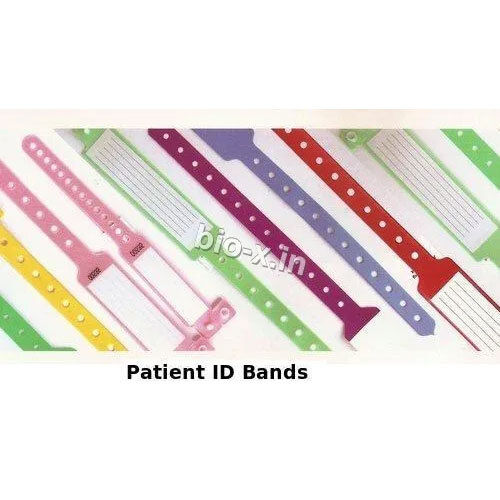How a Patient Identification Band Improves Patient Care and Reduces Dangers
How a Patient Identification Band Improves Patient Care and Reduces Dangers
Blog Article
Discovering the Different Types of Patient Identification Band Utilized in Clinical Facilities
In the elaborate world of medical care, the important function of Patient Identification bands commonly goes undetected. These bands, varying from easy paper wristbands to advanced RFID bands, form the foundation of Patient safety and security procedures, making certain accuracy in Patient Identification. The vast variety of these bands, each with its special benefits and limitations, is typically neglected. As we navigate with this topic, one may acquire understanding right into the refined complexities and important relevance of such bands in clinical facilities.
Understanding the Value of Patient Identification Bands
While they may appear like mere accessories, Patient Identification bands play an important role in clinical facilities. These bands offer as a crucial tool for confirming Patient identification, avoiding medical errors associated to misidentification. Patient Identification bands additionally aid in improving management jobs, making certain exact record-keeping and payment.
Typical Paper Wristbands: Their Use and Limitations
Conventional paper wristbands have been a staple in Patient Identification throughout various clinical centers. While their usage prevails, they nurture particular constraints that may affect their performance in Patient administration. This section will focus on the scope of their application and the inherent drawbacks connected with their usage.
Paper Wristbands: Usage Scope
In the world of Patient Identification, paper wristbands have long held a critical role. These bands are normally used in outpatient settings, where the Patient's remain is temporary. The wristbands consist of essential information such as the Patient's name, date of birth, and a special Identification number. This simple, yet reliable system, allows physician to promptly and accurately recognize individuals, guaranteeing the appropriate treatment is administered. Paper wristbands are likewise made use of in emergency situation situations, where rapid Identification is paramount. Their usage includes events like blood contribution drives and mass inoculation programs, even more stressing their convenience. In spite of developments in innovation, the simple paper wristband stays a reputable and economical option for Patient Identification in different healthcare scenarios.
Limitations of Paper Wristbands
Despite their prevalent use, paper wristbands are not without their downsides. Their physical sturdiness is one of the significant limitations. Exposure to water, sweat, or misuse can make them unreadable or perhaps cause them to degenerate. On top of that, paper wristbands commonly lack the technological capabilities of more modern choices, such as barcoding or RFID chips, limiting their functionality to just displaying written information. The inability to upgrade or change the information on the wristband is another shortcoming. If the information is transcribed, legibility can be jeopardized, leading to potential misidentification. Finally, paper wristbands can trigger discomfort or skin inflammation to some patients, particularly when put on for prolonged periods.
Barcoded Wristbands: Innovations in Patient Identification
While Patient Identification has long been a vital aspect of healthcare, the advent of barcoded wristbands represents a substantial leap ahead. These bands leverage the simplicity of barcoding innovation, allowing for Patient info to be promptly scanned and accessed. They enhance the speed and accuracy of Patient Identification, minimizing the risk of medical errors associated to misidentification.
Radio Regularity Identification (RFID) Bands: an Action Towards Futuristic Medical Care
The advancement of Patient Identification bands has actually produced the introduction of Radio Frequency Identification (RFID) Bands (patient identification band). These investigate this site innovative tools existing key benefits for medical care centers, supplying a much more reliable and technically advanced means of Patient Identification. The execution of RFID in health care is a significant action in the direction of an extra advanced strategy to Patient administration check this site out and security
Comprehending RFID Bands

RFID Bands: Key Benefits
Mostly, these bands enhance Patient safety by supplying precise, immediate Identification, therefore reducing medical errors. RFID bands can save a substantial amount of Patient information, consisting of clinical history and allergies, enabling customized care. Generally, RFID bands represent a significant improvement in Patient Identification innovation, benefiting both clients and healthcare service providers.
Implementing RFID in Health Care
As we enter a technically innovative era, the execution of RFID bands in medical care becomes progressively crucial. These bands supply a smooth method to track and determine clients, ensuring their safety and boosting effectiveness in treatment procedures. RFID bands use countless advantages over standard Identification methods. They can save a huge quantity of information, consisting of the Patient's case history and therapy strategies, which can be conveniently accessed by healthcare carriers. This information assists medical professionals make educated choices relating to the Patient's therapy strategy. RFID bands lower medical mistakes by offering accurate Patient Identification, which is essential in avoiding misdiagnosis or wrong medicine administration. Hence, the application of RFID bands is a substantial step in the direction of improving Patient safety and health care distribution.

Color-Coded Wristbands: Helping in Quick and Accurate Medical Diagnosis
In the busy atmosphere of a clinical facility, color-coded wristbands have emerged as important devices for swift and accurate Identification of a person's clinical problem. These wristbands, put on by individuals, lug particular colors link that match to various medical conditions or statuses. This system is made to use instant aesthetic hints to medical care suppliers, boosting Patient security and care high quality.
Strategies for Reliable Execution and Management of Patient ID Bands
Attaining ideal use of Patient Identification bands demands a well-structured method for their application and administration. Patient education is also vital; individuals have to understand the function of the bands and the need for their continuous wear. It's necessary to have a back-up strategy in location, such as barcode scanning or biometrics, to guarantee that Patient Identification is never ever endangered.
Verdict
Patient Identification bands are important in medical facilities to ensure safety and accuracy. Effective execution and administration of these bands can dramatically decrease clinical errors, increase efficiency, and improve total Patient care.
These bands, varying from straightforward paper wristbands to innovative RFID bands, form the foundation of Patient safety and security methods, guaranteeing accuracy in Patient Identification.The advancement of Patient Identification bands has brought regarding the development of Radio Frequency Identification (RFID) Bands. On the whole, RFID bands stand for a significant development in Patient Identification innovation, profiting both people and health care carriers.
RFID bands reduce clinical mistakes by supplying precise Patient Identification, which is essential in stopping misdiagnosis or incorrect medicine administration. Patient education is likewise critical; patients need to understand the function of the bands and the demand for their constant wear.
Report this page